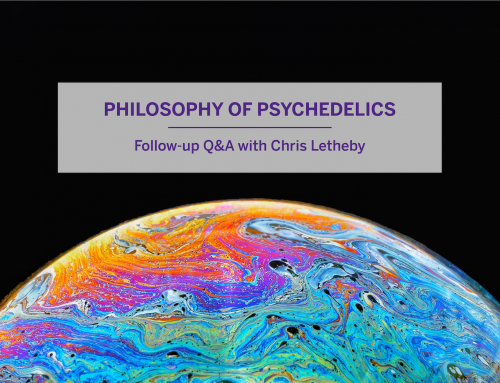An interview with Rotman Institute Visiting Fellow John Bolender
John Bolender has been a Visiting Fellow in the Rotman Institute during the 2011-2012 academic year. He is a philosopher of mind whose primary interest is cognition. Specifically, he has inquired into how the computational core of language may crucially enter into uniquely human cognitive capacities, such as the ability to think beyond the observable. He has also theorized about the nature of interpersonal cognition, arguing that self-organizing patterns of brain activity enter into how we think about social relations on the most basic level. A more detailed profile of Bolender can be found here.
The following interview was conducted with John Bolender via email in January and February, 2012, and is posted to honour the conclusion of his fellowship at the Rotman Institute.
Rob Read: Can you tell me a bit about some of the work you’ve been doing since coming to Western in September?
John Bolender: I’m interested in uniquely human cognitive abilities, and how language might enter into those abilities. I’ve been working on this for some time, actually. So for example, there is a sense in which only humans think beyond the observable. Only humans think about historical personages, molecules, spirits, the afterlife, the Big Bang, and so forth. One might question whether this really is unique to humans. A chimpanzee may have an innate fear of snakes, for example. As another example, a chimp can assemble an arsenal of stones or bits of concrete early in the day to throw at annoying people who visit the zoo later in the day. But do these cases really count? Snakes are quite observable to chimpanzees, even when not actually observed. At the very least, they were observed in the chimp’s ancestral environment. A chimpanzee may also make plans for the future as noted, but these plans evidently involve observables. The bits of concrete and the annoying visitors are all perfectly observable. It’s not like thinking about spirits or wondering if all matter consists of tiny particles. Is language crucial to this human capacity and, if it is, then what exactly is language doing? I suspect that Bertrand Russell’s notion of knowledge by description can help us here; that is, only the human can grasp a descriptive phrase such as the cause of the tides. By means of such a phrase, one can define something unobservable, such as gravity, in term of something observable, such as the tides. We share the ability to think about observables with other species. Thanks to language, we can build upon this ability and define terms designating unobservables as well.
Rob Read: So a certain amount of comparison between humans and other animals is inevitable in your research. What do you make of claims made about primates being taught to communicate using aspects of language?
John Bolender: Communication systems in non-human primates are not very language-like for a number of reasons. One reason is that they lack hierarchical structural, such as one finds in phrases. A determiner phrase, for example, can be embedded in another determiner phrase, such as “[the fish in [the water]].” The whole thing is a determiner phrase, but so is “the water.” One can go even further: “[the child beside [the fish in [the water]]].” In fact, there is no principled limit. The embedding of a phrase within a phrase doesn’t appear to play any role in primate communication, outside human language. It remains an interesting question whether there are language-like systems in non-human cognition, outside communication. There might be. In baboons and dolphins, one finds social structures embedded in super-ordinate social structures. That does look something like phrase structure, due to the hierarchical embedding. It is possible that some non-human species have what is sometimes called a “language of thought” or perhaps even a specialized mental language faculty that functions in some role other than communication. It may be a cognitive adaptation, perhaps for social cognition.
Rob Read: Returning to your work on humans being unique in thinking beyond the observable, are there any human cultures (either historical or contemporary) which have been suspected of only thinking in terms of the observable?
John Bolender: The key idea here, as I see it, is the uneven development of a cognitive potential. Alfred Russel Wallace who, of course, originated the idea of natural selection independently of Darwin, stated that when natural selection is directly responsible for a trait, that trait will be highly uniform within the relevant population. So when moths developed dark wings for camouflage against the soot-covered trees of industrial England, this was a highly uniform trait. Any tendency toward light coloration would be promptly corrected. A lighter moth would be eaten before reproducing, for as long as the trees remained sooty. Now Wallace noted that there are uniquely human cognitive abilities that are not uniformly developed among people. They are very unevenly developed. One obvious example is literacy, although I don’t recall if Wallace mentioned it. Reading and writing are highly developed among some people, less developed among others, and completely undeveloped among other people. For most of human existence, that would be the norm, of course, complete illiteracy. So literacy is not an adaptation, it’s not under the direct control of natural selection. Wallace had in mind some supernatural explanation for such cognitive powers, but never mind that. Presumably, literacy is an offshoot of some other mental power, ultimately a by-product of something which is a Darwinian adaptation. In this case, it’s quite obvious that literacy is an offshoot of language, specifically the externalization of language as a communication system. Another illustration is geographical sense of direction. The Guugu Yimithirr and the Tzeltal would know their geographical coordinates at all times, even after being blindfolded and spun repeatedly or while walking through a cavern. English speakers do not have a highly developed sense of direction, usually quite the opposite. This is another illustration of Wallace’s point. Geographical sense of direction is not an adaptation, although it is evidently a result of language. The Guugu Yimithirr and Tzeltal languages lack terms for “left” and “right.” This forces the speaker to rely heavily on geographical coordinates, for which there are terms. This sharpens a cognitive ability which, among Anglophones like me, remains very rudimentary. To get back to your question, Wallace also noted that abstract thinking varies significantly among people. It is developed to different degrees by different people and in different cultures. The Pirahã of Amazonia evidently are very concrete in their thinking. Generally, gatherer-hunters are more consistently concrete in their thinking than people in other societies, although the Pirahã may be an extreme case. But, in the broader scheme of prehistoric time, one wonders how extreme or extraordinary they would actually be. When one looks at the Lower and Middle Paleolithic, one finds evidence of only sporadic instances of fairly abstract thinking, such as abstract designs and decoration which may have had a symbolic purpose. There is even evidence of sea-faring from the Lower Paleolithic which would clearly involve thinking beyond appearances. But these things are sporadic and isolated. They are few and far between, in other words. The archaeologists Erella Hovers and Anna Belfer-Cohen used the phrase “now you see it, now you don’t.” What this suggests is that highly abstract thinking is not an adaptation but is a result of other cognitive features which ultimately are adaptations. It’s like literacy or directional sense, in other words. It’s not like camouflage coloration. It’s a capacity which may or may not be developed, something accidental.
Wallace’s point does need to be qualified a bit. An adaptive trait can sometimes be turned on or off by the environment; specifically, the relevant gene can be turned on or off. So dramatic variation in a trait’s expression does not necessarily mean that the trait is not an adaptation. Immunity provides an example. People who are socially well connected tend to have good viral immunity and relatively weak bacterial immunity. People who are socially isolated tend to be the opposite. Evidently, this is because, in the ancestral environment, a person with lots of social connections needed greater protection from viruses. Their friends might infect them. Someone more isolated, by contrast, needed more protection from bacteria; for example, if they were infected from an injury and had no one to help them care for the wound. Here we have a trait which can be switched on or off, more specifically a trait that can be turned off in favor of another trait. But that’s not like the cases of directional sense, literacy, and abstract thinking. In each of those cases, you have a trait which can vary widely along a spectrum. The trait doesn’t seem to be under the control of natural
selection, or at least not directly.
Rob Read: The study of human evolution, and evolution more generally, clearly play a big part in your work, but you also have a separate interest in epidemiology research about economic equality and well-being in rich countries by Kate Pickett and Richard Wilkinson. Can you briefly describe this research, and what draws you to it?
John Bolender: In teaching ethics on the introductory level, there’s this great temptation to pull a rather nasty trick on the students. I don’t mean to imply that instructors think of it as a trick; presumably, most don’t. But it’s still misleading, in my view. One introduces students to utilitarianism in its various forms; for example, the view that happiness should be maximized in society or in the universe. One coaxes the students into seeing how reasonable that is. In fact, what else could morality be? Then one springs something like this on them: what if the only way to maximize utility is to persecute an innocent minority? Utilitarianism then suddenly seems vile and loathsome. What an evil doctrine! Often, the students are left with that impression, or so it seems to me. But perhaps they have been misled. The clash between fairness and utility remains a theme in a lot of contemporary moral philosophy. In his book Mortal Questions, Thomas Nagel remarks that equality and utility can clash. He says that the really difficult social questions are how to avoid or resolve this sort of clash. But is it true, in the real world, that equalizing policies versus policies that promote general well being often contradict each other? Would one normally expect a clash at all? The English epidemiologists Richard Wilkinson and Kate Pickett have amassed a lot of evidence supporting the view that income equality in a society correlates with general well being throughout that society. In other words, inequality is bad for everyone, even the rich. Measures of well being include violence, longevity, health including mental health, and even inventiveness as measured in number of patents. To make a long story short, their evidence appears to support the claim that maximizing utility is tightly linked to economic equality. A lot of philosophical wrangling has assumed that the link is not tight; perhaps some of the wrangling could be avoided.
I should point out though that Wilkinson and Pickett only look at data from first-world countries. This is because they want to factor out the role of absolute poverty in causing suffering. This is philosophically important. Derek Parfit discusses the “leveling down objection” to equal outcomes, namely the claim that a natural disaster reducing the better off to the state of absolute poverty of the least fortunate would clearly be a bad outcome. He is somewhat ambivalent as to the implications this objection has, but he does speak of it as having “great force” against those who advocate equal outcomes. Wilkinson and Pickett’s research does not necessarily refute the leveling down objection, since they leave open the possibility that extreme absolute poverty could result in great suffering even when the outcomes are equal.
Rob Read: Returning to your primary research interests, what books or articles are you currently reading in your field?
John Bolender: Books that I’m reading right now are books that I haven’t finished yet, so I hesitate to talk about them. But not too long ago, I was struck by a passage in Steven Pinker’s book The Stuff of Thought. He also addresses the question of how humans are able to think beyond appearances. His proposal is that a combination of metaphor and what he calls “combinatorics” enable humans to do this. An example of what he means by combinatorics is the linguistic capacity to produce, at least in principle, an infinite number of phrases from a finite lexicon. Now, I agree with him to an extent. Metaphorical thinking can be very useful in helping one think about unobservables. It may be helpful to think of an electron as being like an ocean wave or like a ping pong ball flying through space. But there’s a difference between something that augments or facilitates an activity versus something that makes it possible in the first place. Once one has the concept of the invisible entities that cause this visible phenomenon, then one can use metaphors to make it easier to draw inferences about those entities or as a mnemonic to recall what they can and cannot do. Imagining the atom to be like a little solar system may help one remember the various types of subatomic particles by visualizing their various positions. But how does one form that concept in the first place, namely the invisible entities that cause this visible phenomenon? I don’t see how metaphor explains that. I think Pinker goes deeper when he discusses combinatorics. One can see how the ability to combine mental symbols to form the phrase the invisible entities that cause this visible phenomenon could enable one to grasp the concept expressed by that phrase. But Pinker doesn’t say much about how symbols are combined to form such a phrase. One exciting thing about the work of Bertrand Russell is that he proposed specific logical forms for sentences containing such phrases. For example, the unseen object that causes this (visible) phenomenon what Russell called a “definite description,” and he had some definite ideas of his own as to the logical forms of sentences containing them. Although Russell was not a linguist, it turns out that syntactic theory does throw some light on the mental computations which explain how the relevant logical forms are constructed, or mental representations of those forms. I believe it is an interesting hypothesis that some of these computations may be uniquely human, and thus the ability to grasp definite descriptions is also uniquely human. Let’s try to put this all together. Consider this statement: The causes of vapor trails in cloud chambers are like tiny billiard balls. Thinking beyond appearances is made possible by grasping a phrase such as the causes of vapor trails in cloud chambers. That’s the definite description. That’s the first step. The metaphor or simile, like tiny billiard balls, is a second step. It assists one in thinking further about the thing denoted by the description once the description has been used to introduce it.
Rob Read: What are you reading outside your field?
John Bolender: I sometimes find radical viewpoints to be very thought provoking, and so I just started reading Rupert Sheldrake’s book The Science Delusion. I’ve read very little of it, but I suppose I can comment on one small part of it. Sheldrake wants to question a number of statements which he considers to be dogmas of modern science, articles of faith rather than results of reason. One of these supposed dogmas is physicalism, the view that everything can ultimately be understood in terms of physics. The impression I’m getting so far is that Sheldrake wants to suggest that physicalism might be wrong. I would say that it isn’t even wrong; physicalism simply lacks semantic content. The physics which is supposed to explain everything is a mature physics, a physics which does not yet exist. This means that physicalism is the view that everything can be explained by principles which no one currently knows. This, of course, is to say nothing. (Since Sheldrake does not support physicalism, I doubt he would be bothered by my saying this.) Geoffrey Poland wrote a good article about the vacuity of physicalism appearing in the anthology Chomsky and His Critics.
Rob Read: Tell me briefly about someone working in the field of Philosophy today who inspires you.
John Bolender: Philosophy is fascinating, but I’m not sure that any philosopher exactly inspires me. I am inspired by people who make things, such as artists and inventors.
Rob Read: Who specifically inspires you outside Philosophy?
John Bolender: In line with what I just said, Igor Stravinsky and Nikola Tesla come to mind. There are others, but those two come to mind quickly.
Rob Read: Great choices. Why those two specifically?
John Bolender: The paradigm of the sort of person I have in mind could well be Leonardo da Vinci. But regarding the other two: we owe a tremendous amount to Tesla; he invented alternating current, which is what we normally use because of its efficiency. His quest for wireless transmission of power still inspires important innovations; there are prototypes of devices that can be recharged without wires, for example. Stravinsky was the great ironist and fusion artist, seamlessly sounding ultra modernist and archaic at the same time. I think people lose a lot when they simply categorize him as a modernist and overlook the fact that his source materials were usually drawn from the distant past. This is in contrast to someone like, say, Alban Berg who was trying to merge modernism with the near past. Berg is never too far from Wagner or Mahler. But Stravinsky could be revolutionary while simultaneously tracing shadows of forgotten ancestors. In my view, this gives his music a profundity which one has not since found so very often.
Rob Read: Thanks John, it’s been a pleasure.
John Bolender: Thank you very much for the opportunity.





